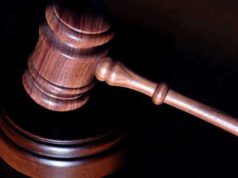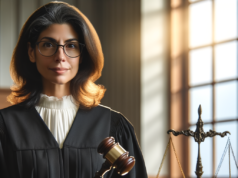Table of Contents

United States v. Lopez: The Landmark Supreme Court Case that Redefined Federal Power
Introduction
The United States v. Lopez is a landmark Supreme Court case that marked a pivotal moment in the ongoing debate about the extent of federal power under the United States Constitution. Decided in 1995, this case challenged the constitutionality of the Gun-Free School Zones Act of 1990, which aimed to regulate firearms near educational institutions. In this 2000-word article, we will explore the historical context of the case, the legal arguments presented, the Supreme Court’s decision, and the enduring implications of this significant ruling.
I. Historical Background
To understand the significance of United States v. Lopez, it is essential to delve into the historical context in which the case arose. The case emerged during a period of increased federal regulation and expansion of government power. The Gun-Free School Zones Act of 1990, which banned individuals from knowingly possessing firearms in school zones, was just one example of the federal government’s efforts to address social issues and crime through legislation.
1. The Gun-Free School Zones Act
The Gun-Free School Zones Act was introduced as a response to rising concerns about gun violence in and around schools. It made it a federal offense for anyone to knowingly possess a firearm in a school zone, as defined by the law. Violators could face a maximum sentence of five years in prison. The act was part of a broader national conversation about gun control and public safety.
2. The Expansion of Federal Power
Throughout the 20th century, the federal government’s authority and reach had expanded significantly. The New Deal era had ushered in a wave of federal regulations, and the federal government increasingly involved itself in areas traditionally left to the states. This expansion of federal power raised questions about the limits of federal authority as defined by the Constitution.
II. Legal Arguments in United States v. Lopez
The case of United States v. Lopez revolved around the constitutional authority of Congress to pass the Gun-Free School Zones Act. Alfonzo Lopez, a 12th-grade student, was arrested for carrying a concealed weapon into his San Antonio, Texas, high school. He was subsequently charged under the federal law.
1. The Government’s Argument
The government argued that the Gun-Free School Zones Act was a valid exercise of Congress’s power under the Commerce Clause of the Constitution. The Commerce Clause, found in Article I, Section 8, grants Congress the authority to regulate commerce among the several states. The government contended that the presence of guns in school zones could affect education and, by extension, interstate commerce. Thus, they argued that regulating guns near schools was within Congress’s power to regulate interstate commerce.
2. Lopez’s Argument
Alfonzo Lopez and his legal team countered that the Gun-Free School Zones Act was unconstitutional because it exceeded Congress’s authority under the Commerce Clause. They argued that the law did not regulate economic activity or commerce and was, in fact, a criminal statute traditionally governed by the states. Lopez contended that the law was an overreach of federal power and infringed on the sovereignty of the states.
III. Supreme Court Decision
The Supreme Court’s decision in United States v. Lopez, delivered on April 26, 1995, was a pivotal moment in constitutional law. In a 5-4 decision, the Court ruled in favor of Lopez, striking down the Gun-Free School Zones Act as unconstitutional.
1. Chief Justice Rehnquist’s Majority Opinion
Chief Justice William Rehnquist, writing for the majority, argued that the Gun-Free School Zones Act was an unconstitutional exercise of Congress’s authority under the Commerce Clause. The majority opinion stated that the law did not have a sufficient connection to interstate commerce to justify federal regulation. Chief Justice Rehnquist emphasized that the regulation of firearms near schools was primarily a matter for state and local governments to address.
2. Dissenting Opinions
The four dissenting justices, led by Justice Stephen Breyer, argued that the majority’s decision would undermine the federal government’s ability to address important social issues. They contended that gun violence in schools had a substantial impact on education, which in turn affected interstate commerce. In their view, the Court’s decision set a dangerous precedent by restricting Congress’s power to regulate activities with indirect economic effects.
IV. Implications and Legacy
United States v. Lopez had far-reaching implications for the balance of power between the federal government and the states. Its legacy can be seen in several key areas.
1. Limitations on the Commerce Clause
The case reinforced the idea that the Commerce Clause has limits. The Court’s decision clarified that not all activities, even those with some connection to interstate commerce, can be regulated by the federal government. This limitation on the Commerce Clause has been a central point in subsequent debates over federal power.
2. Federalism and State Sovereignty
United States v. Lopez affirmed the principles of federalism and state sovereignty. It underscored the importance of preserving the traditional role of states in regulating criminal activities within their borders. The decision was seen as a victory for those who believed in a more limited federal government.
3. The Rehnquist Court’s Approach
The case reflected the Rehnquist Court’s willingness to scrutinize federal legislation and assert the Court’s role in protecting constitutional limits on government power. It was part of a broader trend during Chief Justice Rehnquist’s tenure of limiting congressional authority under the Commerce Clause.
4. Continuing Debates
The decision in United States v. Lopez did not settle the debate over federal power. Instead, it added to the ongoing conversation about the appropriate scope of federal authority. Subsequent cases have continued to grapple with questions of federalism and the Commerce Clause, and the debate persists in legal and political circles.
Conclusion
United States v. Lopez was a pivotal Supreme Court case that addressed fundamental questions about the scope of federal power under the Constitution. The Court’s decision in favor of Alfonzo Lopez reaffirmed the limitations on Congress’s authority under the Commerce Clause and emphasized the importance of state sovereignty. The case remains significant not only for its legal implications but also for its enduring impact on the ongoing debate over federalism and the balance of power in the United States. As the nation continues to grapple with issues of federal authority and states’ rights, the legacy of United States v. Lopez endures as a cornerstone of constitutional law.
Introduction
The United States government has three branches: legislative, executive, and judicial. The legislative branch creates the laws, the executive enforces them, and the judicial branch interprets them. The United States v. Lopez is a landmark case that demonstrates the power of the judiciary to interpret the law and protect individual liberties.
The United States v. Lopez was an important case in the history of the American constitution, which challenged the extent to which Congress could use the Commerce Clause to regulate behavior. The case saw the Supreme Court declare that Congress had exceeded its authority under the Commerce Clause of the US Constitution by regulating the possession of a firearm in a school zone.
This article will explore the background of the case, the issues at stake, the legal process, and the results. Additionally, the article will investigate the broader impact of this case on the United States legal system, particularly its implications concerning the limits of federal power.
Background
In March 1992, Alfonso Lopez Jr., a 12th-grade student at Edison High School in San Antonio, Texas, arrived at school with a loaded .38 caliber handgun. Prior to being found to be carrying the firearm, Lopez had never been in trouble with the law for any reason, and he had no intention of using the gun for anything other than his own protection.
Lopez was ultimately arrested for violating the Gun-Free School Zones Act, a law championed by the administration of President George H.W. Bush. The law prohibited the possession of firearms within a school zone and had been passed by Congress as part of a crackdown on crime and violence in schools.
However, the provisions of the law that Lopez was charged with violating were later found to be unconstitutional.
Legal Issues
The main issue in United States v. Lopez was whether the federal government had the power to regulate the carrying of guns in schools. Justice Antonin Scalia wrote the majority opinion in which he ruled that the federal government had exceeded its authority under the Commerce Clause of the Constitution by passing the Gun-Free School Zones Act of 1990.
The Commerce Clause grants Congress the power to regulate interstate commerce. In litigation surrounding the Gun-Free School Zones Act, the federal government sought to justify the controversial gun law under the Commerce Clause, claiming that Lopez’s actions had a substantial impact on the economy and on interstate commerce.
The government argued that the possession of firearms near schools was a menace to public safety, which affected the economy by discouraging economic growth and reducing property values. Additionally, the government contended that keeping guns off school property would prevent the destabilization of the educational system, which in turn affected commerce.
However, Justice Scalia and the majority opinion challenged this argument and found that the possession of guns in school zones was not a commercial activity, and it did not require significant economic activity or financial transactions.
Justice Scalia’s opinion noted that the Commerce Clause was not intended to be a catch-all power for the federal government but was intended to be an enumerated power that allowed Congress to regulate transactions that were commercial in nature and that had a substantial effect on interstate commerce.
The legal issue of this case boils down to the interpretation of the Commerce Clause of the US Constitution and whether Congress has the authority to regulate activities that are not directly related to interstate commerce. By taking this approach to its logical conclusion, the ruling in the United States v. Lopez can be seen as a defense of state’s rights and a limitation on federal power.
Legal Process
Lopez challenged the Gun-Free School Zones Act, which criminalized carrying firearms near schools, in 1992.
The United States District Court for the Western District of Texas initially denied Mr. Lopez’s motion to dismiss the charges, holding that the Gun-Free School Zones Act was constitutional under both the Commerce Clause and congressional authority to enact criminal legislation under the Necessary and Proper Clause.
However, the decision was later overturned on appeal to the United States Court of Appeals for the Fifth Circuit, which held that the law was unconstitutional. The government then sought review by the United States Supreme Court, which granted certiorari.
Arguments for the government were presented by Solicitor General Drew S. Days III, while the defense was represented by Texas lawyer William C. Bryson.
The Supreme Court heard oral arguments on November 8th, 1994, and on April 26, 1995, issued its verdict in favor of Mr. Lopez, ruling that Congress lacked the authority under the Commerce Clause to regulate the possession of firearms within a school zone.
Results
The Supreme Court’s decision in United States v. Lopez was a landmark case in the history of the US Constitution. The decision restricted federal power under the Commerce Clause and limited Congress’s ability to regulate intrastate matters.
In reaching its decision, the Court adopted a narrow reading of the Commerce Clause, and it demonstrated an increasingly strong endorsement of federalism and protection for individual liberty. The court held that the Gun-Free School Zones Act was unconstitutional since it did not have a direct relation to interstate commerce and hence went beyond the scope of congressional power.
The decision in United States v. Lopez was a significant victory for states’ rights, and it provided a clear statement that a national government could not rely on the Commerce Clause to regulate citizens’ behavior.
The decision was also a victory for gun advocates and those who believe that the Second Amendment protects an individual’s right to own and carry firearms. The ruling reinforced the principle that individuals have the right to bear arms under the Second Amendment, and it placed limits on the federal government’s ability to restrict the use and possession of guns.
Impact on the Legal System
The decision in United States v. Lopez established a precedent that enables the judiciary to intervene and challenge the actions of Congress if they exceed its constitutional mandate. It reaffirmed the principles of federalism, separation of powers, and limited government in the US Constitution. Further, it expanded the reach of judicial review and clarified the authority of Congress to regulate interstate commerce in which both state and federal entities participate.
Since the decision, the courts have been more reluctant to approve laws that rely on the Commerce Clause to justify federal regulation. For instance, in NFIB v. Sebelius (2012), the Supreme Court rejected the Affordable Care Act’s individual mandate, which required individuals to purchase health insurance, saying that Congress exceeded its authority under the Commerce Clause.
Furthermore, United States v. Lopez became the foundation for future cases that challenged the scope and reach of Congress’s power to regulate interstate commerce. For example, the Raich case (2005) involved the use of medical marijuana, in which the Court again carefully analyzed the extent to which Congress can regulate intrastate conduct.
Conclusion
In conclusion, United States v. Lopez was a landmark constitutional case that demonstrated the extent of the court’s power to interpret the Constitution. The case demonstrates the importance of the judicial branch of government and the crucial role of the Constitution in protecting individual liberty and the rights of states.
The Supreme Court’s decision in United States v. Lopez provided a limitation on Congress’s power to regulate intrastate activities under the Commerce Clause and reaffirmed the principle that the regulatory power of Congress was limited in federalist governance. More than two decades after this decision, its impact can still be felt in contemporary jurisprudence.
The United States v. Lopez: The Background
The United States v. Lopez case was the first United States Supreme Court case since the early 1930’s to create laws that limit Congress’s power.
The United States v. Lopez case begins with a man named Alfonzo Lopez. Mr. Lopez was a High School Senior in San Antonio, Texas.
On March 10th of 1992, Lopez carried a concealed handgun into school. The gun was loaded and Lopez had five backup rounds of ammunition tucked away in his jeans. When Lopez was confronted by police and school officials, he admitted to carrying the gun.
The very next day, Alfonzo Lopez was charged with violating federal laws which banned guns on all school properties in the United States. The law Alfonzo Lopez was accused of violating was called the Gun-Free School Zone Act of 1990.
Alfonzo Lopez appealed his arrest by stating that the creation of the law was unconstitutional. Lopez claimed that the laws went beyond the power of the United States Congress; he believed that Congress was not allowed to create laws that essentially control the public school district.
Lopez’s first defense failed; the court ruled that Congress possessed the authority to regulate activities that affected schools throughout the United States.
Alfonzo Lopez was convicted of carrying a weapon on school grounds. He appealed the initial court decision and brought his case to the Fifth Circuit of Appeals. Lopez again claimed that the Commerce Clause was a direct violation of the Constitution to the United States.
The Fifth Circuit overturned the original conviction by stating the charges and the law itself was beyond the power of Congress. In response to this decision, the United States government then appealed to the Supreme Court. The Government wanted the commerce laws to remain in effect.
The United States v. Lopez: The Trial
In the Supreme Court Case, United States v. Lopez, the United States Federal Government’s argument was that the possession of a firearm on or within an educational facility would likely lead to a violent crime.
A violent crime ultimately affects the condition of the school and the wellbeing of the population. Because of this, the government believed that the commerce clause should be upheld and practiced.
In the United States v. Lopez, the Supreme Court backed the previous decision offered by the Court of Appeals. In United States v. Lopez, the United States Supreme Court stated that Congress has the broad power to make laws under the Clause, but these powers were limited and did not extend to the areas of the Lopez case.
The United States v. Lopez took place on November 8th, 1994. The United States Supreme Court ruled in favor of Alfonzo Lopez on April 26th of 1995.






















